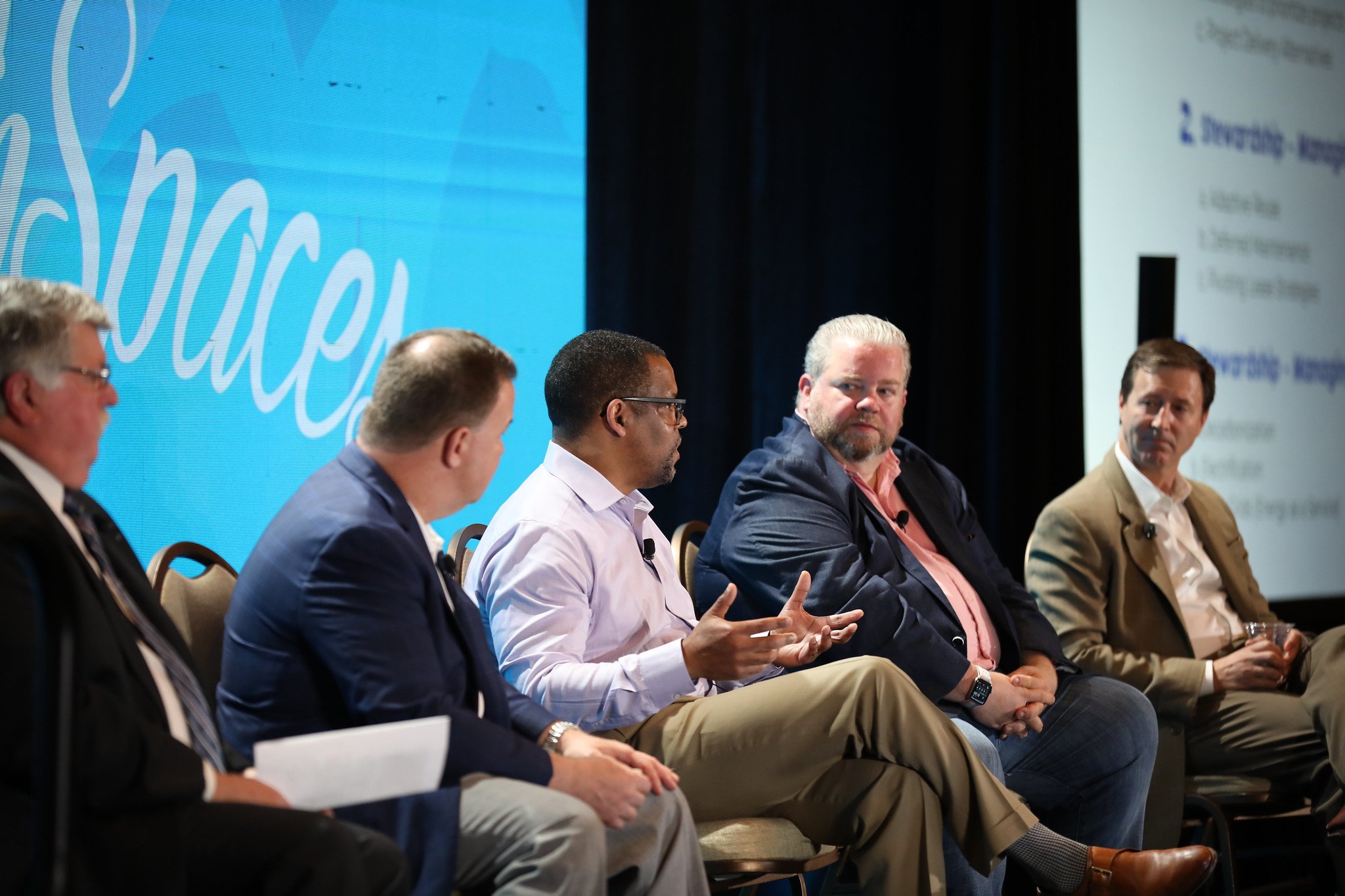If the healthcare industry doesn’t figure out how to design more effective spaces, it will destroy itself – or so argued Travis Messina during the “State of the Industry” discussion at HealthSpaces. The panel had no shortage of existential threats to cover, from the supply chain crises to the need for increased utilization and more flexible patient care settings. Fortunately, the panelists brought more than a few solutions to the table.
Moderated by Mark Kenneday, Director of Healthcare for Gordian, the conversation included Messina, SVP of National Real Estate Services at CommonSpirit Health; Mike Chihoski, Senior Associate VP of Facilities & Services at Rochester Medicine; Jonathan Cogswell, AVP of Facilities Services & Engineering at Northwell Health; and Clayton Mitchell, SVP of Real Estate & Facilities at Jefferson Health. With decades of combined experience, they offered a deep and insightful look at the problems facing the industry today.
Living in the Material World
Of all the challenges the panelists covered, one reigned supreme: materials and supply chain issues. With lead times for some items stretching into months and years, Cogswell has learned to plan ahead and leverage the size of his organization – 23 hospitals and 850 ambulatory facilities across the greater New York area – as he deals with suppliers.
“When we look at negotiating with some of the larger-scale vendors, when you're trying to get a generator for one of your hospitals, and they're telling you it's a 72-week lead time,” he said. “You say, 'No, that's completely unacceptable.’ You then go back and look at your portfolio. You call procurement and you say, ‘All right, I want five generators. Let's go back and negotiate and see what that can do to bring us up the line.’”
By pushing his procurement team to pre-purchase as much as possible – especially as it plans for the next several years of deferred maintenance – he’s managed to work with manufacturers to avoid some of the worst effects of the supply chain crisis.
Chihoski described similar challenges at UR Medicine, where materials shortages have made it difficult to reap the benefits of prefabricated construction. “We're trying to use prefabrication wherever we can," he said. "One of the big advantages early on in prefabrication was accelerating the schedule. I can take an 80-week project down to 40 weeks by working in parallel offsite and onsite and bringing it together. But that doesn't do me any good today if I have a 70-week lead time on my air handler. That savings is absorbed and eaten by the inability to get the supplies that we need to open the facility.”
One of his strategies is to go local, working with Rochester-area trade unions and builders to create a co-op with its own prefab system, shared among multiple users in the community. "I think the more we can try to localize, the more we can try to get in front of the supply chain, that helps reduce some of that risk,” he said.
"Not only are we real estate & facilities professionals, but we have to be sort of closet economists."
Embracing prefab has also helped him build a more diverse labor force, which can be a challenge when young workers who sign up for their local trade unions don’t actually start working for several years. "They're not going to sit around and wait," he explained. "With prefabrication, we're able to get them working at an apprenticeship level right away and in the same workplace. If we're on a bus route or something, they don't have to worry about transportation. They get steady work.”
Acknowledging that while little can be done to hedge against the industry’s current problems, Mitchell stressed the importance of long-term planning. “If you've got somewhat of a decent plan out there, you can begin to put things in place,” he said. Before the pandemic, for instance, he knew he’d need a good deal of structural steel for upcoming projects, and convinced his board to approve a purchase. “It just seemed like the right thing to do, as we were looking at the micro-trends, and then COVID hit. All of a sudden that steel that we bought at $3,000 a metric ton was somewhere around $6,000.”
“Not only are we real estate facilities professionals, but we have to be sort of closet economists,” he added. “We have to begin to look at: where are the trends headed? Where do we hedge?”
Flexibility Through Standardization
If one challenge dominated the conversation, so did one solution. As the panelists looked into the years ahead – from the projects they’re working on now to projects decades down the line – they agreed that for healthcare facilities of the future to survive, they must be flexible above all else.

Travis Messina of CommonSpirit.
At Northwell, Cogswell's pursuing a vision of flexibility through standardization. “One of the things that I've been driving with the health system is trying to get away from that mentality of, here's the orthopedic center and here's the head and neck center,” he explained. “How do we just create a big box facility that is physician office space? And how do we design an exam room that is flexible enough to be utilized by any services? How do we create a space adjacent to it that's maybe a little bit specialized, that can be a procedure space for cardiothoracic, or can be an x-ray room if it's going to be ortho?” By keeping everything in a singular location, he argued, healthcare providers can more effectively leverage their space and their manpower.
Messina shared Cogswell’s vision, arguing that to build the flexible, standardized healthcare facility of the future, organizations will have to convince their clinicians to give up some elements of the past. “There’s a challenge that we have with our clinicians, in that they believe everything that they do is so unique and specific to them,” he said. “Whether it's an operating room, whether it's a procedure space, or whether it's a clinic, the reality is it's an exam room. And an orthopedic surgeon, a GI physician, an internal medicine doc, or a cardiologist can all use that space exactly as it's designed.”
“You have to go to a shared concept,” Mitchell agreed, describing a design his team is working on in which one exam room can be used to treat 85 percent of modalities. “That allows us to build those flexible platforms across the market that can change with the demographics and the market shifts that occur.”
Big Data, Better Design
Fortunately, there’s no shortage of data making the argument for that approach. “One advantage that we have as a system is that we have 6,600 employee physicians, so we get more data than we know what to do with,” Messina continued. “What that data tells us is there is one way to run a clinic. There's one structure that makes sense, and the data proves that that's the efficiency that is necessary in order to drop the portfolio to a size that's manageable. For us, that goal is one and a half exam rooms per doc.”
CommonSpirit isn’t alone in that regard. For years, UR Medicine operated on a four-exam-rooms-per-doctor model, adding four more with each one it hired. There was just one problem: nobody was looking at the utilization data.

Mike Chihoski of UR Health.
“We’re trying to drive to eight turns a day, and most of our exam rooms are 4.6,” Chihoski said. “We just looked and said, 'We could add two million more patient visits a year without adding one more square foot of space if we just utilize and get up to the numbers we need to get to.’”
Of course, it’s not just clinicians who need to buy into the idea. As Cogswell pointed out, it’s often administrators as well. “When we looked to business planning and we looked to utilization, they're content planning for 60 to 65 percent utilization,” he said of his own experiences. “I look at that and I think, 'This is highway robbery!’"
To win his administrators over, he collaborated with the architect on a video model showing what 80 percent utilization would look like. "They were amazed," he recalled. "You show them the data, and then you show them the pretty pictures and all of a sudden their minds changed.”
Getting to Net Zero… Sooner or Later
Looking even further into the future, the panelists closed out by discussing their respective decarbonization efforts. For Mitchell, getting to net zero fits into the broader mission of getting the most out of every dollar, every square foot of space.
"We're tracking about 3 to 4 percent reduction in our energy intensity every year," he said. "It's resulting in about two to three million dollars in savings off of about a $50- to $60-million-a-year utility budget. That's real money for our system… For us, it's really about looking at every project as an opportunity to reduce our energy footprint.”
That’s not to say it’s a cakewalk. Both Chihoski and Cogswell described the difficult decisions they face under New York laws mandating decarbonization targets in the next 30 years. Despite the benefits of converting to renewables wherever possible in the meantime – like UR’s solar array, financed via a PPA – it may not be possible to fully comply with the law while delivering the same level of care to the community.

Clayton Mitchell and Jonathan Cogswell at HealthSpaces.
“We're looking at it from two sides,” Cogswell said. “We are battling with the city right now. We are trying to find exceptions within their law for healthcare facilities, and at the same time, we're trying to figure out how we can get close.” He’s hopeful that a new Northwell building under construction in Manhattan, planned to be fully compliant with the city’s 2034 target, will provide a guide for the system’s existing buildings. At the same time, he expects that, in many cases, it will be cheaper to pay the fines than to retrofit six hospitals.
The industry needs to survive its current existential threats before it can prepare for the next set of existential threats.
Messina, stressing that CommonSpirit is all-in on decarbonization, concluded with a bit of a different take. “My concern with where we sit today is that sustainability takes too much oxygen in the room of bigger issues,” he said. “We have portfolio issues. We have clinician issues. We have labor force issues. We have supply chain issues, and those really have to be the dominant part of the conversation. If we spend time-consuming the discussion around how we're going to respond to something in 2034 or 2040, it becomes really difficult to solve today's problems.”
Ultimately, he argued, the industry needs to survive its current existential threats before it can prepare for the next set of existential threats. “The hope is that as we come out of what is the worst four or five months financially in the healthcare industry, and we look back on that a year from now or two years from now, we're in a better or healthier financial position to make some different decisions effectively.”

Posted by
Collaborate with your Peers!
HealthSpaces is a community for people that plan, design, build and operate spaces where healthcare is delivered.
June 7-9, 2026 | Braselton, GA
Learn More




-4.png)
-Dec-09-2025-05-48-44-4379-PM.png)
-4.png)
-1.png)
-2.png)

Comments